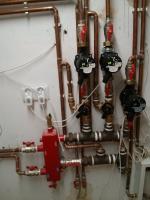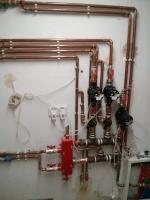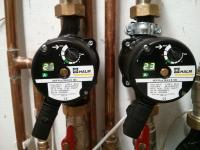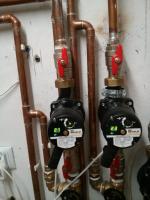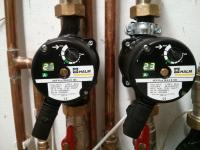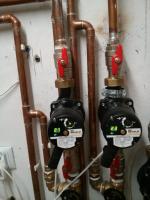Hello
I have a problem with a newly launched installation
Problem:
1. small flows on rotameters on two (first floor, ground floor) manifolds. Despite setting the pump to the maximum "3" speed, the rotameters indicate a maximum of 2 l/min in the loops, and about 0.5 l/min in one on the first floor and two on the ground floor.
Facts:
1. I attach a photo of the installation and a very simplified and illustrative diagram.
2. The pumps are HALM HEP Plus 25-6.0 E 180. I attach documentation for the pump
3. About 700 m of floor heating is connected to the distributor on the first floor, the longest loop is about 90 m. The length of the fi 25 pipe from the manifold to the pump is about 9.5 m, including 3.5 vertically
4. About 600 m of floor heating is connected to the manifold on the ground floor, the longest loop is about 100 m. The length of the fi 25 pipe from the manifold to the pump is about 5 m, including 1.5 vertically
5. The system is vented - it has been venting for about a week
6. I do not know why, but the pumps currently consume about 25-27 W - which means that they do not work with maximum power (50 W), so why such low flows? In my opinion, the flows are too small for the 3rd gear - am I wrong? And if they are too small, where could the error be?
Question
1. On the upstairs manifold, the installer connected two loops from one room to one input and output on the manifold. He just gave tees in front of the manifolds. Is such a solution acceptable?
Thank you in advance for your help
I have a problem with a newly launched installation
Problem:
1. small flows on rotameters on two (first floor, ground floor) manifolds. Despite setting the pump to the maximum "3" speed, the rotameters indicate a maximum of 2 l/min in the loops, and about 0.5 l/min in one on the first floor and two on the ground floor.
Facts:
1. I attach a photo of the installation and a very simplified and illustrative diagram.
2. The pumps are HALM HEP Plus 25-6.0 E 180. I attach documentation for the pump
3. About 700 m of floor heating is connected to the distributor on the first floor, the longest loop is about 90 m. The length of the fi 25 pipe from the manifold to the pump is about 9.5 m, including 3.5 vertically
4. About 600 m of floor heating is connected to the manifold on the ground floor, the longest loop is about 100 m. The length of the fi 25 pipe from the manifold to the pump is about 5 m, including 1.5 vertically
5. The system is vented - it has been venting for about a week
6. I do not know why, but the pumps currently consume about 25-27 W - which means that they do not work with maximum power (50 W), so why such low flows? In my opinion, the flows are too small for the 3rd gear - am I wrong? And if they are too small, where could the error be?
Question
1. On the upstairs manifold, the installer connected two loops from one room to one input and output on the manifold. He just gave tees in front of the manifolds. Is such a solution acceptable?
Thank you in advance for your help



